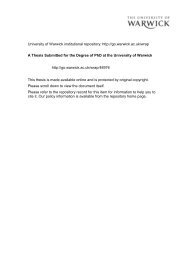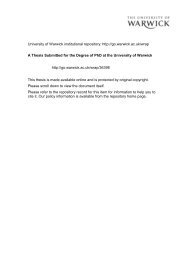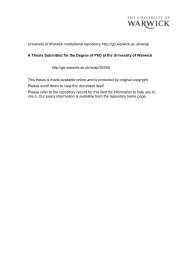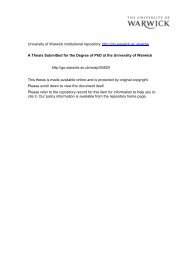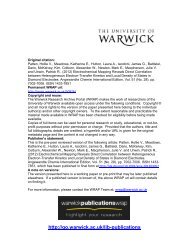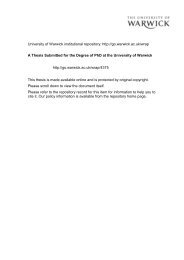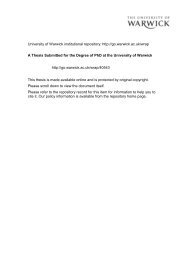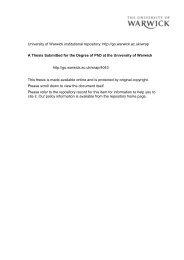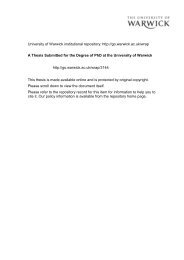Download (13Mb) - WRAP: Warwick Research Archive Portal ...
Download (13Mb) - WRAP: Warwick Research Archive Portal ...
Download (13Mb) - WRAP: Warwick Research Archive Portal ...
Create successful ePaper yourself
Turn your PDF publications into a flip-book with our unique Google optimized e-Paper software.
sex forerunners may liberate them from the sensation that 'everything has already<br />
been written,' the form imposed upon them by the male-authored text presents other<br />
challenges.<br />
Most feminist critics are interested in establishing what happens when a<br />
woman becomes the writing subject, as opposed to its object - when a female reader<br />
decides to become a female writer. Reading informs and forms the work of every<br />
writer, but many critics, like Elizabeth Bronfen, believe that in the case of the female<br />
writer the bonds between reading and writing are tighter: 'Because the historically<br />
real woman writer cannot articulate herself entirely devoid of cultural fictions of<br />
femininity, writing as a woman transpires into an act of reading cultural texts [...]<br />
critically, so as to enact the implied contradiction." This act of critical reading was a<br />
necessary step towards writing and away from the nineteenth century image of the<br />
woman reader whose relationship to the text is one of such passivity that it can<br />
constitute a corruptive danger. Does this still hold true towards the end of the<br />
twentieth century?<br />
This is not so much a quest to trace a 'female' quality in writing, but rather, as<br />
Maria Rosa Cutrufelli suggests, a questioning of how 's'incama nella scrittura<br />
l'esperienza del singolo corpo di chi scrive e, allo stesso tempo, l'esperienza storica<br />
del 'genere sessuale' a cui chi scrive appartiene." It is this general emphasis on<br />
tracing the experience of women as subjects in the present, as opposed to striving<br />
towards a utopian future or idealised past notions of an essential female, which has<br />
found a particularly favourable reception with some Italian theorists. The leading light<br />
of this movement is Adriana Cavarero, for whom 'the female subject can emerge<br />
when she decides to be her own subject, to think about her own subject taking herself<br />
as a starting point, here and now.,6 It is this subject, frequently riddled with<br />
contradictions, who, as a writer, also finds herself increasingly aware of her dialogue<br />
2).<br />
4 Elisabeth Bronfen, Over Her Dead Body: Death, Femininity and the Aesthetic (Mancherster:<br />
Manchester University Press, 1992), p. 404.<br />
5 Maria Rosa Cutrufelli cit. by Carol Lazzaro-Weis in From Margins to Mainstream: Feminism and<br />
Fictional Modes in Italian Women's Writing, 1968-1990 (Philadelphia: University of Pennsylvania<br />
Press, 1993), p.17. CutrufeIIi writes: 'non si tratta deIl'eterno quesito se esista 0 meno 'una qualita<br />
femminile' 0 'una qualita maschile' della scrittura. Quesito che, cosi posto, risulta ambiguo e forse<br />
d'impossibile soluzione (a meno che non si voglia banalizzare il tutto, come pure spesso si fa,<br />
rroclamando la neutralita della scrittura e l'androginia dello scrittore).'<br />
Adriana Cavarero, 'The Need for a Sexed Thought' originally given in 1986 at the first nationwide<br />
conference of Women's Cultural Centres, held in Siena and published in Italian Feminist Thought: A<br />
Reader, ed. by Paola Bono and Sandra Kemp (Oxford: Blackwell, 1991), pp. 181-185 (p.185).<br />
2




